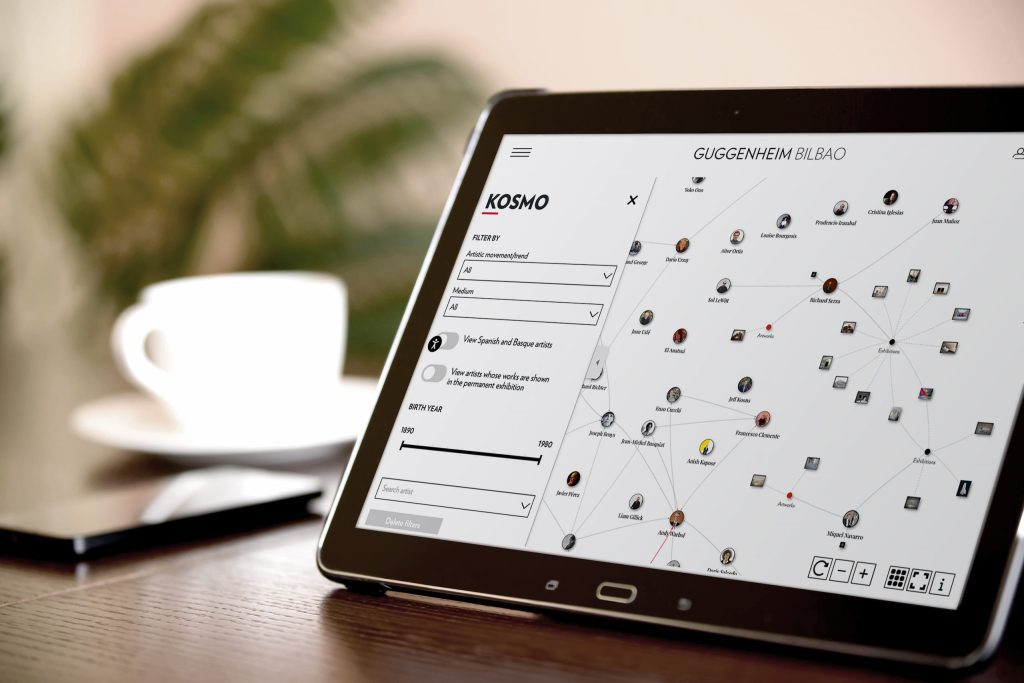Hey creators, artists, and researchers! Remember how during university/academy, as you amassed knowledge about artists, periods, and styles, you searched for ways to weave it all into one canva, structurize and connect it? Piles of notebooks, bookmarks, sticky notes, and crazy mind maps covering several walls in the room… Did we foresee a decade ago that a virtual tool would be developed that finds and represents all these connections on its own? Remarkably, it’s not only designed for researchers but also accessible to art enthusiasts everywhere.
We are referring to the new tool we developed this spring for the Guggenheim Museum Bilbao: KOSMO- Interactive Knowledge Graph created by La Tempesta.
Explaining some tricks of this project
The KOSMO tool is an interactive knowledge graph based on the TEMP Knowledge Graph Tool.
Some boring theory: An Interactive Knowledge Graph is structured data that represents entities and relationships between them in the form of a graph. In the case of KOSMO, it is a constellation of artists connected through various resources such as biographies, and exhibitions.
The task was to organize the data to show artists not in a conventional way, but in a graph style, highlighting the dependencies between the artists’ nodes.
BTW, we processed profiles of 80 artists from the GMB collection and 800 related nodes (exhibitions and artworks).
The trickiest part and what differentiates KOSMO from similar knowledge graphs is the three-level dependence data:
- Artists and relations between them.
- When you click on multiple artists, not only is their artwork displayed, but also the exhibitions they participated in, allowing users to see the connections between artists who shared the same exhibitions.
- A pop-up page of the artist when you click on their profile, which includes biography, artworks, exhibitions, available videos, connections and bibliography.
Imagine no longer having to scour for all the information about Cy Twombly, including his personal and group exhibitions at the Museum and his connections with other artists. For example, we can see that the works by Jean-Michel Basquiat, an artist from the next generation inspired by Twombly’s art, were presented alongside Twombly’s in seven joint exhibitions. Or that they also shared a common artistic bridge in the figure of Julian Schnabel. Wow!
In KOSMO, we created complex connections to provide users with simple access to all information related to the artist.
Filters
In KOSMO, it was crucial for each node to be part of multiple groups or filters, allowing artists to be categorized under various criteria such as mediums or nationalities. This capability enables artists to appear in multiple relevant groups. For instance, through filters like “medium → sculpture,” “Basque and Spanish artists,” and “born until 1930,” we discover that Eduardo Chillida is the only artist fitting all these categories.
A Linked Data model
The Grafo serves as an information aggregator from various sources. Its interface, designed for linked data models, is both advanced and adaptable to diverse use cases. It also complies with Semantic Web standards and aligns with the Linked Art initiative.
TEMP Knowledge Graph Tool is an ideal solution for cultural institutions of all sizes – from major museums to small galleries and collections.
Ready to see how easily The Grafo can be implemented for your collection? Request a free demo today and discover how it integrates with your existing systems.
For more information, visit the Guggenheim Museum Bilbao KOSMO
